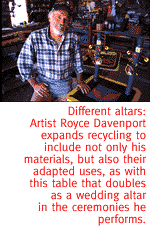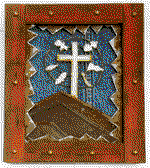

|

Royce Davenport Has Discovered High Times With Lowly Objects From Yesteryear.
By Margaret Regan
GARAGE AND ESTATE sales are Royce Davenport's favorite
things, almost. He doesn't like elegant sales where the wealthy
are unloading the old silver for a song, mind you. Instead, Davenport
ferrets out the backcountry roads where the merchandise is pure
junk.
"Usually the guy has died and the wife just wants the junk
out of there," Davenport said. "I went to one recently
in Vail, and I was in a wonderland of tools, hardware and all
kinds of stuff from the '40s." It's an honor, he believes,
to be in the dusty realms of the old-fashioned tinkerers, "those
old guys working in there with that old savvy of how things work."
 More often than not the old guys' old tools, tins, and broken-down
excuses for furniture end up in Davenport's art. A pathetic coffee
table, for instance, joined forces with some tacky plastic cowboys,
flickering electric lights and old bullets in "Way Out West,"
a funked-out wall triptych now gracing the gallery walls at Tohono
Chul Park. Re-Visions: Art from Recycled Materials celebrates
the transformative imaginations of some 14 Tucson artists, who,
like Davenport, make art of what everybody else throws away.
More often than not the old guys' old tools, tins, and broken-down
excuses for furniture end up in Davenport's art. A pathetic coffee
table, for instance, joined forces with some tacky plastic cowboys,
flickering electric lights and old bullets in "Way Out West,"
a funked-out wall triptych now gracing the gallery walls at Tohono
Chul Park. Re-Visions: Art from Recycled Materials celebrates
the transformative imaginations of some 14 Tucson artists, who,
like Davenport, make art of what everybody else throws away.
Some of the art verges on the elegantly abstract--Steven Derks'
sleek metal weldings, for instance--while the downright downhome
is the province of the likes of Jerry Hall, maker of horses and
cacti and funny owls out of giant, painted tin cans. Davenport
falls somewhere in between. A trained painter and illustrator,
for 10 years he was art director at the Tucson Weekly.
All of his works playfully incorporate ancient junk, but the best
of them also show off his painterly proclivities.
"Takin' the Back Road" at Tohono Chul is what you might
call a punched-out painting. There's definitely a painterly sensibility
at work, what with the alluring sunset-yellow sky, deep-blue mountains
and desert-rose road, but the piece breaks out of the painting's
flat planes. A real-life blue toy truck ambles along the painted
road; the cacti are actual saguaro scraps, and the rocks are painted
clay. Part sculpture, part painting, the work has a deliciously
uneven surface. There's a reason for that.
 "I had worked in the two-dimensional field since forever,"
Davenport said one morning last week, seated in the flowery bower
of springtime Tohono Chul Park. "I used to do T-shirt designs,
pen and ink, painting, oil pastels. But I saw that as we moved
into the electronic era, the work was being done more and more
by computer. Just about anybody who could push a button could
layer images on top of each other. Computer art is very flat to
me...For me, to have to rely on a machine to make an artistic
statement was boring."
"I had worked in the two-dimensional field since forever,"
Davenport said one morning last week, seated in the flowery bower
of springtime Tohono Chul Park. "I used to do T-shirt designs,
pen and ink, painting, oil pastels. But I saw that as we moved
into the electronic era, the work was being done more and more
by computer. Just about anybody who could push a button could
layer images on top of each other. Computer art is very flat to
me...For me, to have to rely on a machine to make an artistic
statement was boring."
So Davenport opted out of a media world being fast overtaken by
digital wizardry ("I made the definite choice to become obsolete
before the next computer," he says); and turned to three-dimensional
work that, so far, can only be made by human hands.
Now 52 years old, Davenport sees himself as part of a fading tradition.
A "third-generation craftsman," he's the grandson of
a Midwestern sign painter who labored "in the good old days
when everything was hand-lettered. My daddy started helping him
at age 5 or 7. My dad became a commercial illustrator. He was
damn good. I was raised in an environment where art was going
on."
Davenport has drawn all his life, but it was a while before he
thought of doing art full-time. After getting out of the military,
he went home to Indiana to work as a motorcycle mechanic. But
on a random motorcycle trip around the West, he came to Tucson
and, like many before him and since, "fell in love with the
Sonoran Desert." Once relocated to his new home, he took
advantage of the GI Bill to study at Pima and Yavapai colleges,
immersing himself in studio art and art history.
"We need to take the time to look at the things that people
took time to make," as he puts it. Nowadays, he finds himself
taking time with the objects of the not-too-distant past, the
almost forgotten West of the '30s, '40s and '50s, when handcrafted
leather and iron commonly adorned ranches and adobes.
"In my pieces I make an attempt to go back to that time,
when handwork really counted. I try to make present in my pieces
that feeling of a dusty old shop...these pieces are not from today."
In his work, he also tries to elevate the common object, making
old weed clippers or milagros or pieces of jeans add up to something
more than the sum of their parts. He admires painter Cynthia Miller
("in her paintings, a chair can become a shrine") and
photographer William Lesch ("he is just really pumping a
presence" into his illuminated desertscapes). An ordained
minister for 23 years, Davenport believes that in the weddings
he performs, he comes the closest to merging significant object
with spirit. The Tohono Chul show exhibits the table, spectacularly
painted in yellow, turquoise and green, that he uses as an altar
at the weddings.
"I found it in a barrio house. It was pretty ragged. I hammered
and painted and sawed it. I added shock absorber caps off my old
Ranchero. (At the weddings) I put on candles, the wedding rings,
fresh flowers." The celebration of art and the celebration
of the wedding make for "a perfect thing--they can come together."
 Davenport's own marriage, to a nurse, has yielded two children,
a daughter, age 9, and a son, age 4. His departure from the newspaper
coincided roughly with the birth of his son, and he's devoted
most of the last four years to raising the kids. To be sure, he
never gave up his tinkering. During his time at home, he's added
to his desert backyard two play towers, a ramada, a fish pond,
waterfalls and a cookhouse. ("I've been a building fool.")
It's only in the last year, as his son has grown slightly more
independent, that Davenport's been able to concentrate once again
on making art objects.
Davenport's own marriage, to a nurse, has yielded two children,
a daughter, age 9, and a son, age 4. His departure from the newspaper
coincided roughly with the birth of his son, and he's devoted
most of the last four years to raising the kids. To be sure, he
never gave up his tinkering. During his time at home, he's added
to his desert backyard two play towers, a ramada, a fish pond,
waterfalls and a cookhouse. ("I've been a building fool.")
It's only in the last year, as his son has grown slightly more
independent, that Davenport's been able to concentrate once again
on making art objects.
He came to fatherhood late, in his 40s, and one piece in the show,
"Takin' the Back Road," is an homage to his old, pre-dad
freedom. The change hasn't been easy, but he's content.
"I've had my way for decades. It's time to give something
back," he said. And his kids seem to be thriving in the creative
disorder of junk that makes its way into art. His son likes to
make assemblages of stuff; and his daughter won a prize for painting
at the Pima County Fair last year.
"I've also come to realize as much as I think of myself as
an artist, I may be setting the stage for them to be good artists.
By paying attention to them and their growth, providing an environment
and visual space, I may be the platform from which the rocket
is launched...They may be the ones to conquer the world with their
creativity." 
Re-Visions: Art from Recycled Materials continues
through Sunday, June 21, at Tohono Chul Park Gallery, 7366 N.
Paseo del Norte. Exhibit Hall hours are 9:30 a.m. to 5 p.m. Monday
through Saturday, 11 a.m. to 5 p.m. Sundays. Suggested donation
is $2. For more information, call 742-6455.
|
 |





